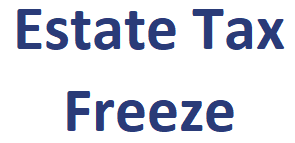Estate tax freeze
An estate tax freeze is a strategy used by wealth managers to transfer future appreciation and tax liability to a future generation. This tax efficient strategy usually involves a partnership or corporate structure. A gift tax will be due on the value of the asset when the transfer is made. However, the asset (including any future appreciation in value) will be exempt from future estate and gift taxes, hence the name estate freeze.
On this page, we discuss the advantages and disadvantages of using an estate tax freeze. We also discuss an example to highlight how exactly the freeze works.
Corporate estate tax freeze
Corporate estate tax freezes are used to transfer wealth to a future generation. Let’s consider an example to explain the mechanics. Imagine the founder of a company wishes to leave the company to her children. The investment manager advises her to restructure the company into two classes of stock, a voting preferred class and a nonvoting common class of stock. The restructuring is done such that these shares are worth the current value of the company. The common stock is worth $0.
Since the common stock has no current value, there should be no tax on the initial gift to her children. The preferred stock (with a fixed dividend) is not expected to increase in value as the company grows. The value of the preferred stock is frozen. Future growth in the company will only increase the value of the common stock.
The advantage of this approach is that, by retaining the voting preferred stock, the founder continues to have sole control of the business. The disadvantages are the following:
- this approach is only possible if the founder has full control over the company to be able to do the restructuring
- this approach does not generate cash flows for the founder
- any unrealised gain still exists and remains due since the estate tax freeze only shifts taxation of future appreciation
An alternative approach, which does allow lower taxes on the current unrealised gain, is by applying limited partnership valuation discounts.
Summary
Minimizing transfer tax costs is difficult when the gains already exist. While the above approach allows shifting the taxation of future appreciation, it does not reduce gift taxes related to the existing unrealised gain.

